 Chronic Viral Infections: Symptoms and Natural Solutions
Chronic Viral Infections: Symptoms and Natural Solutions
Chronic viral infections can be one of the major issues in the development of autoimmune and other chronic inflammatory conditions. Everyone has viral infections at one time or another during their lives. Our immune system is our natural defense mechanism to remove viruses from our bodies.
Many viral infections remain in our bodies and become chronic. In fact, it is estimated that humans carry between 8 and 12 persistent viral infections! This happens when the immune response is not sufficient to eliminate the virus permanently.
Chronic viral infections can have a huge impact on your health. They are linked to a number of health problems including autoimmune conditions and even cancer. This article will discuss symptoms of chronic viral infections and natural solutions to beat these infections.

What are Viral Infections?
A virus is a small infectious agent with genetic material, RNA or DNA, surrounded by a coat of protein, lipid (fat), or glycoprotein. They can only replicate inside the cells of another organism, so they are parasitic. Viruses can infect humans, animals, plants, and microorganisms.
There are more than 400 viruses that can cause infections in your body. When our bodies encounter a virus, our adaptive immune response acts to clear the primary infection. With some viruses, the immune response is not enough to eradicate the virus and it becomes chronic.
Chronic viral infections can result from a variety of viruses (1). They escape from our immune system by modulating, or regulating, our immune response. These viruses cause persistent infections which may last for life.

How are Viruses Spread?
A virus exists only to reproduce. When it reproduces, its offspring spread to new cells and new hosts. Viruses are spread from person to person, and from mother to child during pregnancy or delivery.
Viruses are transmitted through:
- Direct contact with bodily fluids such as saliva, coughing, or sneezing
- Sexual contact
- Contaminated food or water
- Insects that carry them from one person to another.
After the initial infection, some viruses remain dormant in the body. Certain triggers can provide fuel to these viruses and the dormant virus is reactivated. Viruses such as HIV and herpes simplex virus (HSV) are especially harmful because they are able to hide in our bodies, persisting only in DNA form.

How Viral Infections Affect our Health
Chronic viral infections are systemic and can last for months or years. They can cause diseases by compromising our immune system and altering the genetic material within the cells they have hijacked.
Chronic viral infections are a major trigger for inflammation and can cause many unwanted symptoms and health conditions. One of the main symptoms of chronic viral infections is fatigue. In fact, one study showed that 78% of people with chronic fatigue syndrome had markers of reactivated EBV and almost 50% had increased antibody titers to HHV (2).
Viruses can affect your central and peripheral nervous system. Human herpes viruses (HHV) are common in the brains of the elderly (3). They are usually dormant but can become active in response to stress or a compromised immune system.
The herpes simplex virus is known to damage the central nervous system and the limbic system in the brain. There is strong evidence that it is linked to the development of Alzheimer’s disease. This can happen years or decades after the initial infection (4).
Numerous autoimmune diseases are linked to chronic viral infections, including autoimmune thyroid conditions and multiple sclerosis (MS) (5,6). With autoimmune diseases, the body’s immune system triggers an inflammatory response to its own tissues. The body responds as if normal tissues are infected and attacks these tissues. Autoimmune conditions develop as a result.
Studies have also linked chronic viral infections to cancer. In fact, it is estimated that one out of every ten cancers arises from viral infections (7).

Common Viruses
There are 8 types of herpes viruses that affect humans. After the initial infection, all herpes viruses remain latent within our cells and may reactivate at a later time. The most common viruses are EBV, CMV, HSV, and VZV.
1. Epstein Barr Virus
The Epstein Barr Virus (EBV) is one of the most common human viruses in the world (8). In the US and developed nations, more than 90 percent of people over 20 are infected with EBV (9). In less-developed countries, 90% of people are infected by age 2. Once infected, the virus remains in people for their lifetime.
EBV is known as human herpesvirus 4 and is a member of the herpes virus family. It is transmitted from human to human through direct contact with bodily fluids such as saliva, blood, and seminal fluid.
EBV is the leading cause of mononucleosis (also called mono or the kissing disease). It has also been linked to neurological complications, autoimmune conditions, cancer, and other illnesses. EBV may increase your risk of developing lupus, multiple sclerosis, rheumatoid arthritis, celiac disease, inflammatory bowel disease, and type 1 diabetes (9).
Common symptoms of EBV are extreme fatigue, inflamed sore throat, fever, headache, body aches, swollen tonsils, rash, swollen lymph glands in the neck and armpits and swollen liver and/or spleen. After the initial bout of symptoms, the virus establishes a dormant infection in which the viral genome persists in the cells of the immune system. Periodically, the infection is reactivated by triggers that fuel viruses and other pathogens in the body. For more information about EBV and natural remedies to improve EBV, check out this article.

2. Cytomegalovirus
Cytomegalovirus (CMV) is a beta herpesvirus that is common and can affect almost anyone. This infection is never cleared, and the virus persistently infects salivary and mammary glands and the kidneys. Most people are unaware they have CMV because it rarely causes problems in healthy people (10).
For people with a compromised immune system or women who are pregnant, CMV is a cause for concern. If a pregnant woman develops an active CMV infection during pregnancy, she can pass the virus to her baby. It can also spread through breast milk.
When first infected with CMV, your symptoms may be similar to mono, including fatigue, fever, sore throat, and muscle aches. People with weakened immune systems may experience more serious signs and symptoms affecting their eyes, lungs, liver, esophagus, stomach, intestines, and brain. Babies with CMV can have significant signs and symptoms.
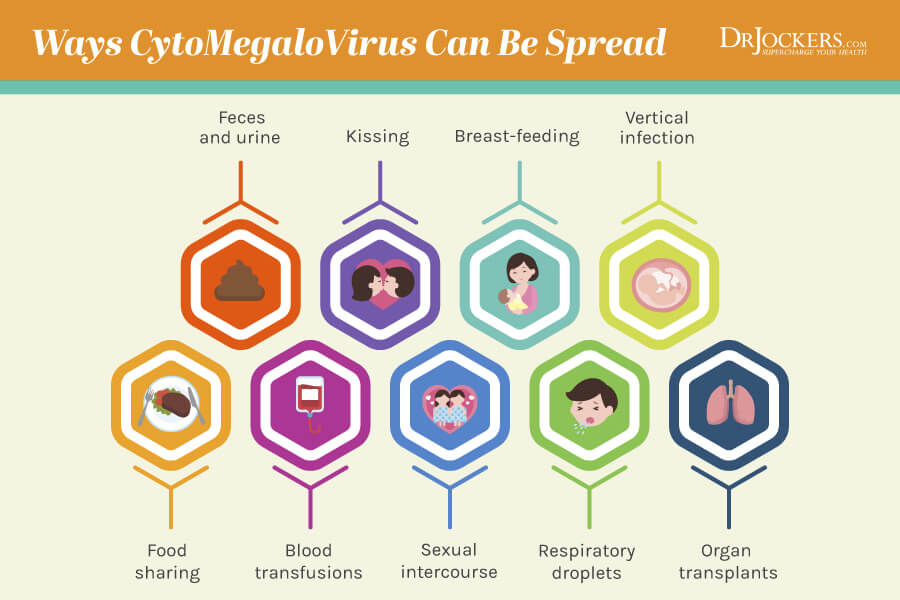
3. Herpes Simplex Virus
Herpes simplex viruses, commonly referred to as herpes, are categorized into two types:
- Herpes type 1 (HSV-1) – oral herpes
- Herpes type 2 (HSV-2)- genital herpes
HSV-1 is transmitted through oral secretions or sores on the skin. It is highly contagious and is spread through kissing or sharing toothbrushes, lip balm, utensils, water bottles, and similar objects. It is estimated that 67% of people under age 50 worldwide have HSV-1 (11).
HSV-2 is spread through sexual contact and the infected person may have sores around their genitals or rectum. Around 11% of people between 15 and 49 years old have HSV-2.
Both infections are lifelong and asymptomatic. Herpes goes through periods of being dormant, but certain factors can trigger reactivation. These factors include stress, fatigue, illness, and menstrual periods.
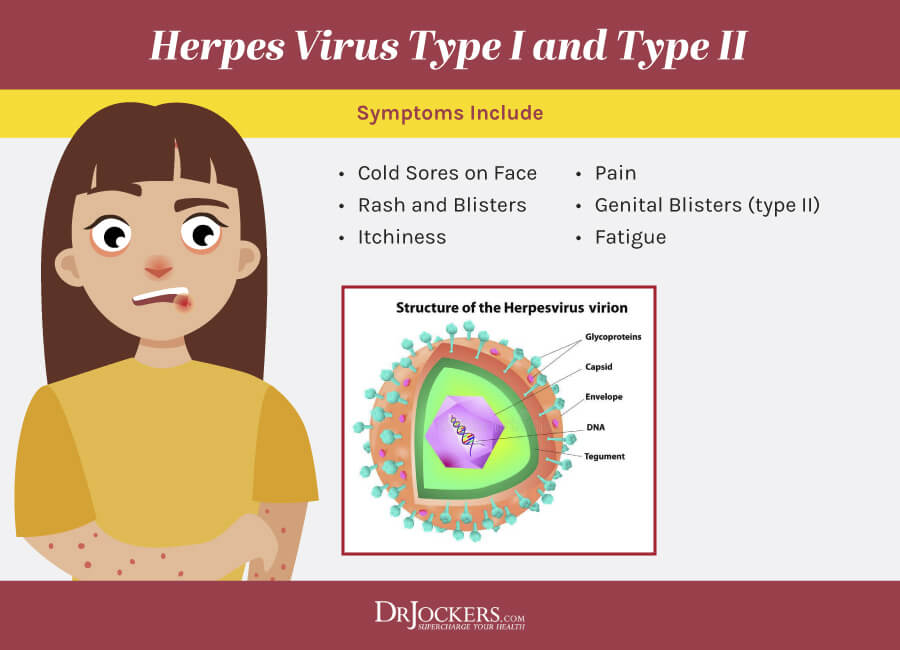
4. Varicella-Zoster Virus
The varicella-zoster virus causes chickenpox and shingles. After you have had chicken pox, the varicella-zoster virus lies inactive in nerve tissue near your spinal cord and brain. Years later, the virus may reactivate and travel along nerve pathways to your skin as shingles.
Shingles (herpes zoster) is a viral infection usually accompanied by a painful rash (12). Shingles can occur anywhere on the body, but most often on your torso. Usually, it appears as blisters that wrap around your body.
Pain, sometimes intense, is often the first symptom of shingles. Some people experience shingles pain without developing the rash. Other symptoms of shingles include burning, numbness, tingling, sensitivity to touch, and itching.
Not everyone who has had chickenpox will develop shingles. Shingles is most common in older adults and people with weakened immune systems. It can cause serious complications including vision loss, neurological problems, skin infections, and postherpetic neuralgia.

Retroviruses
A retrovirus is a virus that is composed mostly of RNA rather than DNA. A retrovirus has reverse transcriptase, an enzyme that gives the virus the ability to insert a copy of its genome into the DNA of a host cell that it invades (13). This changes the genome of the host cell. Retroviruses are either single stranded RNA or double stranded DNA.
Human immunodeficiency virus (HIV) is the most well-known retrovirus. Other human retroviruses include the human T-cell lymphotropic virus 1 (HTLV-1). HTLV-1 is associated with certain T-cell leukemias and lymphomas.
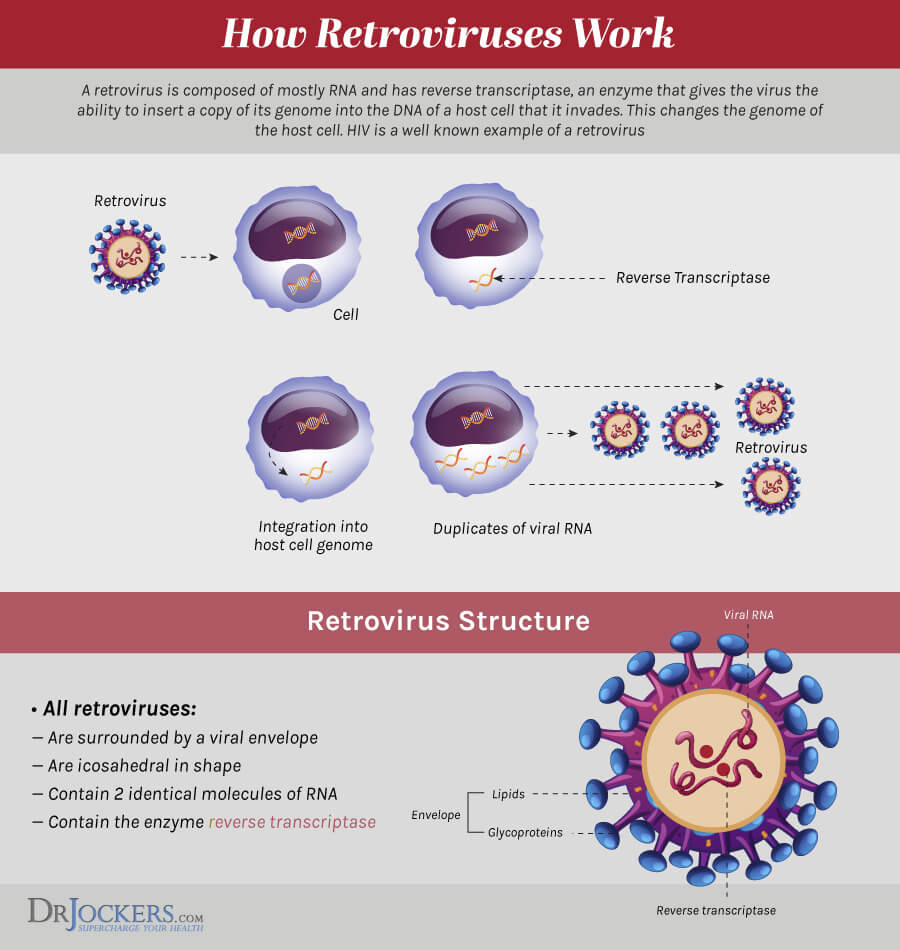
Ways to Reduce your Viral Load
When it comes to viruses, in many cases we aren’t going to eliminate them completely, but we can significantly reduce the viral load and that will have a positive impact on our energy and quality of life. Consuming an antiviral diet and adding targeted supplements to your protocol can help reduce your viral load and improve chronic viral infections.
It is also critical to reduce stress, improve sleep quality and reduce your exposure to toxins. You can follow the diet and take the specific supplements but if you are overwhelmed with stress, not sleeping well or in a home that is full of mold than you will not get well. However, if you do your part to improve those areas than these 3 strategies can help you significantly reduce your viral load.

1. Antiviral Diet
A healthy diet is one of the best ways to boost your body’s ability to heal from a viral infection. The foods you are eating can help suppress or stimulate viral growth. To protect your body from susceptibility to viral infections, you should eat a diet high in lysine and low in arginine.
Lysine is an essential amino acid that plays an active role in growth and development, collagen formation, calcium absorption, and cholesterol regulation. It supports your immune system and can help suppress the growth of viruses.
Arginine is an amino acid that competes with lysine for absorption. It is known to stimulate viral growth. Eating foods that are high in lysine and relatively low in arginine is important when you have a viral infection.
Foods to Include
Foods with the highest lysine to arginine ratio include:
- Salmon – Coho, wild-caught
- Dairy – grass-fed cheeses and yogurts
- Poultry– pastured, organic is recommended Turkey has the highest lysine/arginine ratio
- Beef – steaks from grass-fed and finished cows
Fruits to include on an antiviral diet are lemons, limes, avocados, and cranberries. You can also include most vegetables.
An antiviral diet includes whole, unprocessed foods. You should consume clean protein, organic vegetables and fruits, and healthy fats. Clean protein sources are grass-fed meats, pasture-raised, organic chicken and eggs and wild-caught fish. Healthy fats include avocados, olives, coconuts, and their oils along with grass-fed butter and ghee.
If you feel poorly taking in any of the foods that are higher lysine, you can avoid it. We want to avoid any food sensitivities and many people with viral issues struggle with dairy protein in cheese and yogurt. Try it out and see how your body responds.
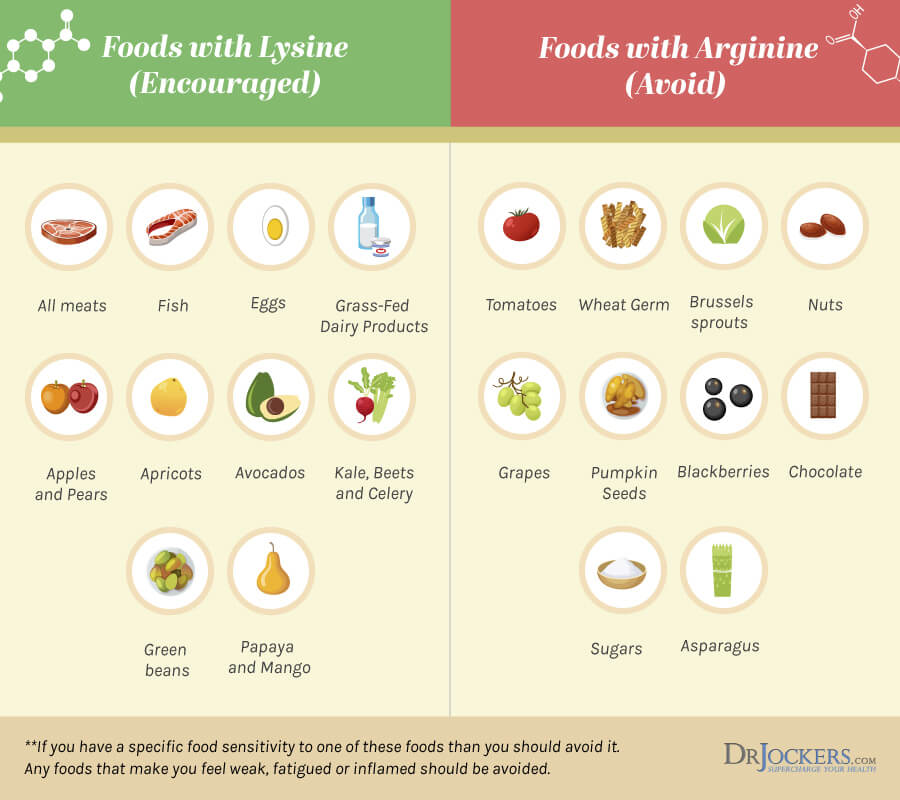
Foods to Avoid
Foods to avoid on an antiviral diet include nuts, most seeds (including sunflower, sesame, pumpkin), grains (wheat, rice, oats), caffeine, chocolate, pasteurized dairy, and sugar. Vegetables to avoid are Brussels sprouts, onions, and corn. These foods are high in arginine.
It is also important to avoid inflammatory foods that can weaken your immune system such as sugar and processed foods. Consuming refined sugars can suppress the body’s immune responses.
Other foods to avoid are processed foods and vegetable oils, as well as meat and dairy from conventionally raised animals and farmed fish. These foods often contain genetically modified organisms (GMOs), trans-fats, pesticides, herbicides, and other toxic ingredients. Consuming these foods creates inflammation in the body, extra acidity in the tissues, and alters the immune system.

2. Fasting
Fasting is a fantastic strategy for improving chronic viral infections. Fasting is one of the oldest and most powerful healing strategies. You can start by implementing intermittent fasting.
Intermittent fasting is when you consume your calories within a window of time each day and fast the remainder of the day. This fasting strategy is great for reducing inflammation and boosting the immune system. Additionally, intermittent fasting stimulates cellular autophagy, supports the digestive healing process, improves genetic repair mechanisms, improves insulin sensitivity, and reduces the risk of chronic diseases (14).
Start with a simple fast of 12 hours for 1-2 weeks and see how your body responds. This short fast is basically from dinner until breakfast the next day. You can increase your fasting time as your body adapts to not eating at certain times of the day. For the best intermittent fasting strategies and information on how to fast, check out this article.
Overtime as you practice intermittent fasting, your body will get more metabolically flexible and able to go longer without food. You may even want to consider an extended fast such as a 5-day water fast which can be particularly powerful. Here is a great article on what happens in your body during a 5-day water fast.

3. Supplements to Combat Viral Infections
There are a number of supplements that may be helpful for preventing and improving chronic viral infections. Remember that supplements are not a “cure,” but instead they help the body to do the healing. It is also critical to follow the diet and lifestyle strategies, sleep well and clean up your environment to get the best benefits from these supplements.
There are blood tests to help determine whether you have a viral infection and which type of infection is chronic or active in the body. I review those at the bottom of the article. But taking these specific supplements can help you overcome these viral infections.
Lymphatic Support
Your lymphatic system is a vital part of your immune system. It is a network of lymph nodes connected by lymphatic vessels that transports lymph throughout the body. Lymph contains oxygen, proteins, and other nutrients that nourish the tissues.
It transports foreign substances, cancer cells, and dead or damaged cells that may be present in tissues into the lymphatic vessels and lymph organs for disposal. Harmful microorganisms are filtered out and destroyed in the lymph nodes.
My top herbs for lymphatic support include turkey rhubarb, sheep sorrel, slippery elm bark, astragalus root and graviola chuchuasi. Turkey Rhubarb is a powerful herbal remedy that smooths the muscles of your intestines. It is highly effective for detoxification, cleansing, and constipation (15). Sheep Sorrel is an effective herb to reduce inflammation, respiratory problems, swelling, and diarrhea. It may also be used for soups and sauces (16).
Slippery Elm Bark is an herb that Native Americans used to remedy fevers, wounds, and sore throats. It may be effective for inflammation, sore throats, cough, inflammatory bowel disease (IBD), urinary tract infections (UTIs), and digestive issues (17, 18).
Astragalus Root is commonly used for its immune-boosting benefits. It may also be beneficial for longevity, heart health, blood sugar issues, and sexual health (19). Graviola Chuchuasi is a powerful remedy full of antioxidant and anti-inflammatory properties. It may be beneficial for blood pressure issues, blood sugar problems, stomach concerns, infections, and cancer (20).
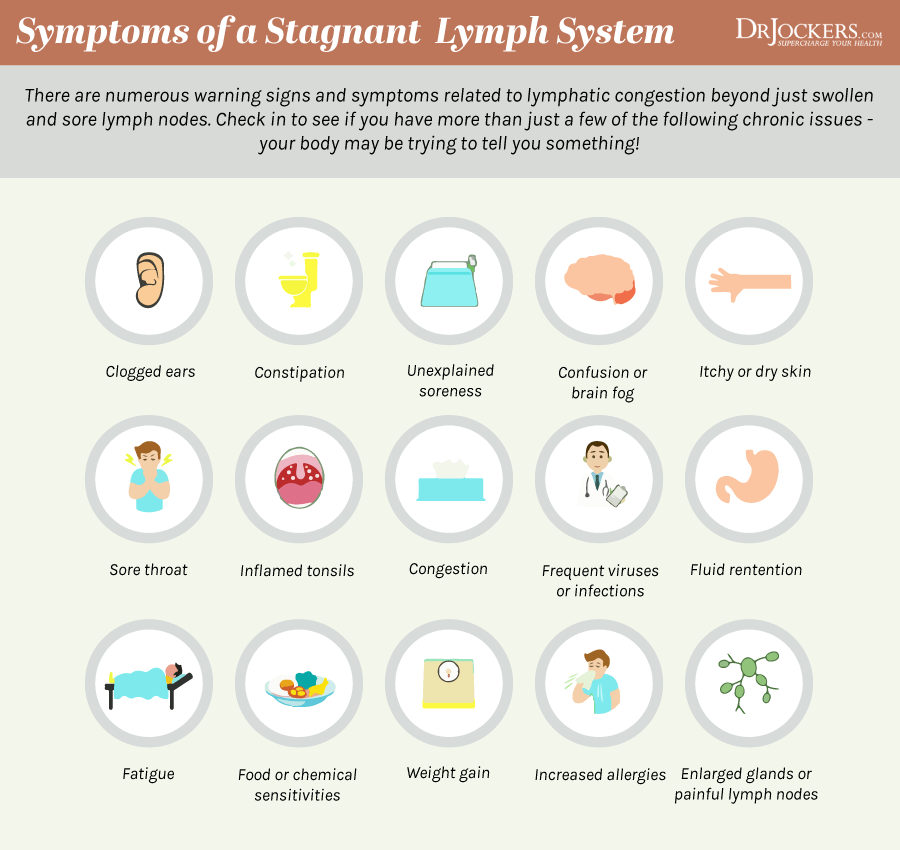
Use Anti-Viral Herbs Internally
Taking anti-viral herbs internally may help your body to fight viral infections, improve immunity, and serve as a beneficial supplement for overall immune health. Olive leaf extract, broccoli sprouts, and mulberry are particularly beneficial anti-viral herbs I recommend supplementing with.
A 2014 study has shown that oleuropein, the active ingredient in olive leaf extract has anti-inflammatory, antioxidant, and disease-fighting benefits. Various research, including a 2016 randomized, double-blind study has shown the anti-viral benefits of broccoli sprouts on peripheral blood natural killer cells.
Furthermore, a 2018 research has shown the antiviral benefits of mulberry seeds and juice. Supplementing with olive leaf extract, broccoli sprouts, and mulberry may support your body’s fight against chronic viral infections (21, 22, 23).

Use Bioactive Carbons
BioActive Carbons are a type of carbon that helps to create and sustain life in a cell. They are generated when important microbes decompose old plant matter and make it into nutrient-rich dirt and soil. There are two different plant-based acids that are bioactive carbons: fulvic and humic acid.
They are made up of carbon, hydrogen, and oxygen just like your body. BioActive Carbons help to improve your immune system. They fight pathogens, including viruses and bacteria. They help your body’s detoxification pathways and improve your overall health. To learn more about BioActive Carbons, I recommend reading this article (24).

L-Lysine
If you have a herpes infection or are prone to recurrent herpes infections, supplementing with L-lysine may be helpful. L-lysine is an essential amino acid that is important for a healthy immune system.
It has been shown to be effective for reducing the recurrence of herpes simplex infections, and for reducing the severity of symptoms and the healing time of HSV infection (25). We recommend taking roughly 500-1000 mg with each meal or 2-4 grams daily.
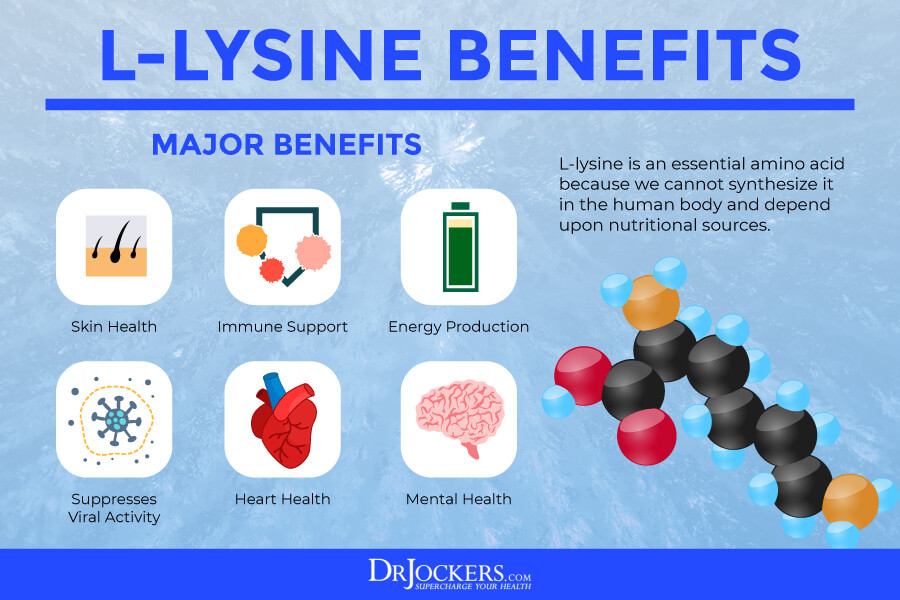
Comprehensive Blood Analysis
The Comprehensive Blood Analysis is a comprehensive test that includes a Complete Blood Count (CBC), Complete Metabolic Panel, urinalysis, lipid panel, iron panel, CRP, and thyroid panel. The CBC shows the distribution of white blood cells and red blood cells. White blood cells regulate the immune system and can indicate altered immune activity.
Lymphocytes are a type of white blood cell. There are two main types of lymphocytes, T cells and B cells. These cells regulate the body’s short and long-term immune responses. An elevation of lymphocytes on the CBC (over 40%) may indicate that you have a viral infection.
Monocytes are also tested on the CBC. Monocytes are a type of white blood cell that forms macrophages. Macrophages are immune cells that reside in specific tissues and protect them from infiltration of pathogens including viruses. When monocytes are over 7%, this may indicate a viral infection.
Comprehensive Viral Panel
The Comprehensive Viral Panel tests for the major viruses that impact human health, including EBV, CMV, HSV, HHV-6, Varicella Zoster and Rubeola. This test measures antibodies and viral antigens to determine how the body’s immune system is reacting to these viruses.
This test can reveal which infections are present and whether they are active or chronic infections. If you have a history of chronic pain or fatigue and increased lymphocytes and/or monocytes on the CBC, this test may be helpful.
Conclusion:
Everyone develops viral infections during their lifetime. Some of these infections remain in your body and become chronic. Chronic viral infections weaken your immune system and can wreak havoc on your health.
If a chronic viral infection is impacting your health, the strategies discussed in this article may be very helpful. You should run a CBC to determine how your immune system is functioning. A comprehensive viral panel may also be prudent to reveal which viruses are creating an immune response in your body and whether these viruses are active or chronic.
If you want to work with a functional health coach, I recommend this article with tips on how to find a great coach. Our website offers long-distance functional health coaching programs with our expert practitioners. For further support with your health goals, just reach out and our fantastic coaches are here to support your journey.
Inflammation Crushing Ebundle
The Inflammation Crushing Ebundle is designed to help you improve your brain, liver, immune system and discover the healing strategies, foods and recipes to burn fat, reduce inflammation and Thrive in Life!
As a doctor of natural medicine, I have spent the past 20 years studying the best healing strategies and worked with hundreds of coaching clients, helping them overcome chronic health conditions and optimize their overall health.
In our Inflammation Crushing Ebundle, I have put together my very best strategies to reduce inflammation and optimize your healing potential. Take a look at what you will get inside these valuable guides below!






Would these supplements be ok for my 11yr old?
Hey Dori, Yes, however I would recommend working with a functional health practitioner to customize a specific dosage plan based on his/her needs! This article can help.
Thank you!
Completing 4weeks doxy for acute lyme. Had bullseye, positive test. Where start to detox etc Borellia?
Hey Sarah, I am sorry to hear that you are struggling with this! This article addresses steps that I recommend to repair your body and heal!
Hi,
Been having several bouts of cellulitis. How to get my system back to normal base. I have RA, celic, thank you
Hey Donna, It sounds like there is a lot going on! This infection can be very serious and I wouldn’t hesitate to work with a functional health practitioner who will customize a specific plan based off of your health needs! This article can help: https://drjockers.com/functional-nutrition-tips-to-find-a-great-health-coach/
Excellent excellent article on viruses. One of the best references I have ever read on this subject. With these guidelines and supplements, I have been able to fine tune and enhance the antiviral program I was placed on by my practitioner. My prior antiviral and detox program was too strong/harsh for my system. With your information, I am detoxifying effectively and without feeling sick and debilitated all day long. Detox should be effective but not overly stressful on the body I believe. Thank you so much!! I am so grateful.
Yes it is important to make it tolerable and we stress the low and slow method to reduce unwanted side effects!
Dr Jockers I have tried to reach Danielle one of your coaches but I have not heard back from her. We had one brief email exchange 2 days ago but I have written several more to her since. I need to talk to somebody even if she is out of town . I have a paid plan with Dr Jockers. Thank you Sandra
Hi thanks for the information I really need this antiviral package an eating plan
Yes it is super helpful!
Hello,
I have had pericarditis for almost 4 months, which my cardiologist thinks is caused by an unknown virus. So I have been trying to follow the antiviral and anti-inflammatory diets. I am new to trying to eat without grains, and am struggling trying to find recipes that are grain free and nut free… so many substitute almond flour or almond butter etc. Are there specific nuts that I should be trying to avoid on the viral diet or all nuts? And should I be avoiding all things nut based?
Thanks, Misty
Hey Misty, yes it is best to reduce the amount of nuts and eat more meat, avocados, fish and veggies.